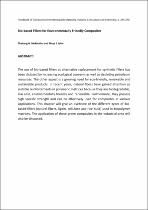JavaScript is disabled for your browser. Some features of this site may not work without it.
- ResearchSpace
- →
- Research Publications/Outputs
- →
- Book Chapters
- →
- View Item
| dc.contributor.author |
Mokhothu, Thabang H

|
|
| dc.contributor.author |
John, Maya J

|
|
| dc.date.accessioned | 2017-07-28T09:02:46Z | |
| dc.date.available | 2017-07-28T09:02:46Z | |
| dc.date.issued | 2017-03 | |
| dc.identifier.citation | Mokhothu, T.H. and John, M.J. 2017. Bio-based fillers for environmentally friendly composites. Handbook of Composites from Renewable Materials, Volume 1, Structure and Chemistry, p. 243-270. | en_US |
| dc.identifier.isbn | 978-1-119-22362-7 | |
| dc.identifier.uri | http://eu.wiley.com/WileyCDA/WileyTitle/productCd-1119223628.html | |
| dc.identifier.uri | http://hdl.handle.net/10204/9345 | |
| dc.description | Copyright: 2017 Scrivener Publishing LLC. Due to copyright restrictions, the attached PDF file only contains the abstract of the full text item. For access to the full text item, kindly consult the publisher's website. | en_US |
| dc.description.abstract | The use of bio-based fillers as alternative replacement for synthetic fillers has been dictated by increasing ecological concerns as well as depleting petroleum resources. The other aspect is a growing need for eco-friendly, renewable and sustainable products. In recent years, natural fibers have gained attention as suitable reinforcements in polymeric matrices because they are biodegradable, low cost, environmentally friendly and renewable. Furthermore, they possess high specific strength and can be effectively used for composites in various applications. This chapter will give an overview of the different types of bio-based fillers (natural fibers, lignin, cellulose and rice husk) used in biopolymer matrices. The application of these green composites in the industrial area will also be discussed. | en_US |
| dc.language.iso | en | en_US |
| dc.publisher | Wiley. Scrivener Publishing. | en_US |
| dc.relation.ispartofseries | Worklist;18424 | |
| dc.subject | Bio-fillers | en_US |
| dc.subject | Biodegradability | en_US |
| dc.subject | Biopolymers | en_US |
| dc.subject | Cellulose | en_US |
| dc.title | Bio-based fillers for environmentally friendly composites | en_US |
| dc.type | Book Chapter | en_US |
| dc.identifier.apacitation | Mokhothu, T. H., & John, M. J. (2017). Bio-Based fillers for environmentally friendly composites., <i>Worklist;18424</i> Wiley. Scrivener Publishing.. http://hdl.handle.net/10204/9345 | en_ZA |
| dc.identifier.chicagocitation | Mokhothu, Thabang H, and Maya J John. "Bio-based fillers for environmentally friendly composites" In <i>WORKLIST;18424</i>, n.p.: Wiley. Scrivener Publishing.. 2017. http://hdl.handle.net/10204/9345. | en_ZA |
| dc.identifier.vancouvercitation | Mokhothu TH, John MJ. Bio-based fillers for environmentally friendly composites.. Worklist;18424. [place unknown]: Wiley. Scrivener Publishing.; 2017. [cited yyyy month dd]. http://hdl.handle.net/10204/9345. | en_ZA |
| dc.identifier.ris | TY - Book Chapter AU - Mokhothu, Thabang H AU - John, Maya J AB - The use of bio-based fillers as alternative replacement for synthetic fillers has been dictated by increasing ecological concerns as well as depleting petroleum resources. The other aspect is a growing need for eco-friendly, renewable and sustainable products. In recent years, natural fibers have gained attention as suitable reinforcements in polymeric matrices because they are biodegradable, low cost, environmentally friendly and renewable. Furthermore, they possess high specific strength and can be effectively used for composites in various applications. This chapter will give an overview of the different types of bio-based fillers (natural fibers, lignin, cellulose and rice husk) used in biopolymer matrices. The application of these green composites in the industrial area will also be discussed. DA - 2017-03 DB - ResearchSpace DP - CSIR KW - Bio-fillers KW - Biodegradability KW - Biopolymers KW - Cellulose LK - https://researchspace.csir.co.za PY - 2017 SM - 978-1-119-22362-7 T1 - Bio-based fillers for environmentally friendly composites TI - Bio-based fillers for environmentally friendly composites UR - http://hdl.handle.net/10204/9345 ER - | en_ZA |






